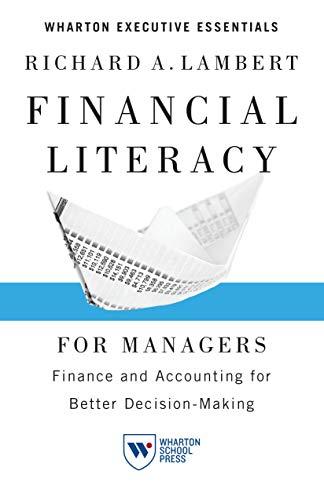Question
Read this article and answer questions at the bottom. The Rise of the Jumbo Student Loan Most students with loan balances exceeding $50,000 in 2010
Read this article and answer questions at the bottom.
The Rise of the Jumbo Student Loan
Most students with loan balances exceeding $50,000 in 2010 had failed to pay down any debtfour years late
During the housing boom of the 2000s, jumbo mortgages with very large balances became a flashpoint for a brewing crisis. Now, researchers are zeroing in on a related crack but in the student debt market: very large student loans with balances exceeding $50,000. A study released Friday by the Brookings Institution finds that most borrowers who left school owing at least $50,000 in student loans in 2010 had failed to pay down any of their debt four years later. Instead, their balances had on average risen by 5% as interest accrued on their debt. As of 2014 there were about 5 million borrowers with such large loan balances, out of 40 million Americans total with student debt. Large-balance borrowers represented 17% of student borrowers leaving college or grad school in 2014, up from 2% of all borrowers in 1990 after adjusting for inflation. Large-balance borrowers now owe 58% of the nations $1.4 trillion in outstanding student debt. This is comparable to mortgage lending, where a subset of high-income borrowers hold the majority of outstanding balances, write Adam Looney of Brookings and Constantine Yannelis of New York University. A relatively small share of borrowers accounts for the majority of outstanding student-loan dollars, so the outcomes of this small group of individuals has outsized implications for the loan system and for taxpayers, the authors say. The problem is particularly acute among borrowers from graduate schools, who dont face the kinds of federal loan limits faced by undergraduate students. Half of todays big balance borrowers attended graduate school. The other half went to college only or are parents who helped pay for their childrens education. Grad school borrowers tend to be among the best at paying off student debt because they typically earn more than those with lesser degrees. But the rising balances unearthed in the latest study suggest that pattern might be changing. Overall across the U.S., one-third of borrowers who left grad school in 2009 hadnt paid down any of their debt after five years, compared to just over half of undergraduate students who hadnt, federal data show. Mr. Yannelis and Mr. Looney, a former Treasury Department official under President Barack Obama, built the research out of exclusive access to federal student-loan and tax data. The findings on graduate schools are particularly noteworthy because the government offers little information on the loan performance of grad students, who account for about 14% of students at universities but nearly 40% of the $1.4 trillion in outstanding student debt. The data set accompanying the new study breaks down performance for students at 934 schools with 100 or more graduate borrowers whose loans first came due in 2009. At Nova Southeastern University , a large private nonprofit school in South Florida, just over half of the 10,319 graduate borrowers who departed in 2009 had reduced their balances by just a dollar or more five years later, the data show. Many sought or received advanced degrees in health fields. They collectively borrowed $412 million for grad school, or an average $40,000, excluding any debt from other schools, the study showed. George Hanbury, Nova Southeasterns president, said many of the schools former grad students went into health fields, where salaries often start low and then rise quickly later on. They all have the capability to see higher incomes the longer they stay in their career, which means they have the greater capability to increase their rate of payback than they do in the earlier stage, Mr. Hanbury said. He said the schools former students earn more, on average, than workers with bachelors degrees. At Arizona State, a large public university in Tempe, 51% of the 4,000 grad students who left in 2009 had reduced their initial balances by 2014. Arizona State, through a spokesman, declined to comment. At Walden University, a large collection of graduate programs run by Wall Street giant Laureate Education Inc., 53% of 9,530 graduate borrowers paid down their balances by at least a dollar or more over five years. Many were enrolled in programs involving social services. Walden, in a statement emailed by a spokeswoman, said many former graduate students are in fields that often pay modestly at first but serve a social good. This is consistent with our social mission where we are educating in professions like teaching, social work, and counseling, for example, and those professionals may not earn significant salaries right after graduation, but who are making a significant societal impact, the statement said. Most borrowers from those schools arent in default. Instead, a big share of them are in debtrelief plans that lower monthly payments, known as income-driven repayment, or theyve won permission from the government to postpone payments due to a range of circumstances, including unemployment or further study.
Questions
| 1. According to this article, what are the main findings about the overall status of student loan debt? |
| 2. What is accrued interest? |
| 3. How is it possible that a debtor with a student loan balance is not in default on the loan but the loan balance increases, rather than being paid down? In your answer, describe how a loan payment is allocated between interest and principal repayment. |
Step by Step Solution
There are 3 Steps involved in it
Step: 1

Get Instant Access to Expert-Tailored Solutions
See step-by-step solutions with expert insights and AI powered tools for academic success
Step: 2

Step: 3

Ace Your Homework with AI
Get the answers you need in no time with our AI-driven, step-by-step assistance
Get Started


